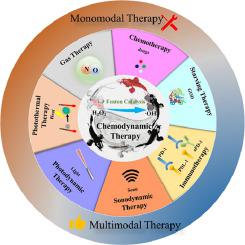Applied Materials Today ( IF 7.2 ) Pub Date : 2020-11-03 , DOI: 10.1016/j.apmt.2020.100864 Xiangyu Meng , Xuezhong Zhang , Mei Liu , Bo Cai , Nongyue He , Zhifei Wang

|
The recently developed reactive oxygen species (ROS)-manipulated nanocatalytic medicine in cancer treatment based on the Fenton reaction, defined as chemodynamic therapy (CDT), has been extensively studied and got fast progress. However, the heterogeneity and complexity of tumors impair the oxidation efficiency of Fenton reaction to some degree. For this reason, various modified strategies, such as Fenton-like reaction, photo-enhanced Fenton reaction, and Fenton catalytic-enhanced synergistic therapy, are being explored to improve the efficiency of CDT and traditional therapeutic methods. In this review, the recent progress in the design and application of Fenton nanocatalysts that employ Fenton or modified Fenton reaction for CDT is highlighted. Then, the latest signs of improvement in Fenton catalysis-enhanced cancer synergistic therapy are systematically presented. Finally, the purpose of this review is also to provide a better understanding of Fenton's reaction in cancer treatment and to anticipate the obstacles and challenges in the future development of CDT-based nanocatalytic medicine and combined therapy.
中文翻译:

基于Fenton反应的纳米药物在癌症的化学动力学和协同治疗中的作用
最近开发的基于Fenton反应的活性氧(ROS)操纵的纳米催化药物被定义为化学动力学疗法(CDT),已经得到了广泛的研究并取得了快速的进展。然而,肿瘤的异质性和复杂性在一定程度上损害了Fenton反应的氧化效率。因此,正在探索各种改进的策略,例如芬顿样反应,光增强芬顿反应和芬顿催化增强协同治疗,以提高CDT和传统治疗方法的效率。在这篇综述中,着重介绍了采用Fenton或修饰的Fenton反应进行CDT的Fenton纳米催化剂的设计和应用的最新进展。然后,系统地介绍了芬顿催化增强的癌症协同治疗的最新进展。最后,本综述的目的还在于更好地理解芬顿在癌症治疗中的反应,并预测基于CDT的纳米催化药物和联合疗法在未来发展中的障碍和挑战。











































 京公网安备 11010802027423号
京公网安备 11010802027423号